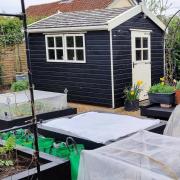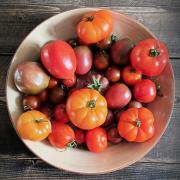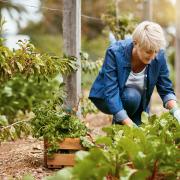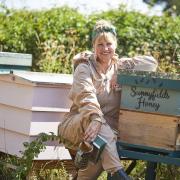Summer time and the living is easy . . . except when the vegetable plot is at its most productive.

July is juggling in the garden. Do you weed, water, feed, make compost, sow for autumn or harvest?
This is when I mumble about living in a flat, as there seems so much to do. But I have learned to embrace this wonderful time of year when crops are ripening to perfection.
Don’t grow too much over these furious months and make sure you set time aside to process your harvests searching out delicious recipes for the freezer and larder.
We never know what we are in for with rainfall, and if the last few years are a pattern, we need to have guttering in place filling our butts, and a good 5cm deep mulch on the surface of containers and all thirsty crops. Trickles of water on the surface of warm soil will evaporate before you get back to your butts.
To enable deep down watering of real drinkers, like courgettes, cucumbers and squash, use empty plastic water bottles. Cut out the bases and plant the bottles upturned at an angle towards the roots.
I always look at the forecast each week ahead to know when rain is coming (accuweather.com). How frustrating it can be to spend hours watering, only for it to rain the following day.
You decide on your watering routine, preferably early morning or late evening (never midday). A good soaking a few times a week during dry spells is sufficient even for tomatoes. Mulch and a boost in autumn or early spring with plenty of organic matter helps enormously. Keep an eye on your plants – they will tell you what they need.
Feeding crops in a productive plot is also hugely important. If like me you make maximum use of your soil space 12 months of the year, growing up to 3- 4 different crops sometimes in the same spot- you need to give a bit back to that nutritionally depleting soil. Autumn or spring preparation with plenty of added organic matter is fundamental to successful growing but cropping later on will need a boost with a few more nutrients. Always look on the bottle – organic is definitely preferred for productive growing and read the N: P: K ratio on the back
(Nitrogen: Phosphorous: Potassium). In a nutshell a higher Nitrogen level encourages green growth, Phosphorous strengthens plants and roots and Potassium or Potash is needed for proliferating fruiting and flowering.
Making a high potash/ Potassium Comfrey feed is a joy, as you will always have a great supply of freely available fuel for fruiting and flowering crops, so search out method and how to grow comfrey on-line.
Pest control is the next threat in high summer. Aphids, micro- slugs and fungal infections can all peak now so it is vital to maintain healthy plants for strong defence. I highly recommend biological pest control for the most likely offenders. Read up on the RHS web site (rhs.org.uk), as it is one of the greatest revolutions for safe pest control in the kitchen garden. My prevention starts in March with the first of 3 doses of Nemaslug (March / June / Sept) to keep my green crops and young seedlings protected. There are plenty of helpful additions I use routinely like pheromone traps for codling moth, sticky, yellow sheets in the greenhouse for trapping the fliers and essential small mesh netting over brassicas and peas, mange tout and sugar snaps.
July is without a doubt hectic but as my dear Pa and gardening guru has always taught me, ‘don’t forget to smell the roses ’.
JOBS FOR JULY
• Plant or sow runner beans beside 8ft wigwams
• Make sure brassicas are netted (min 7mm mesh)
• Plant young sweet corn plants in blocks, not rows
• Sow rows of salad leaves in a shady spot if they bolt
• Dig up your garlic / shallots over a dry few days
• Make lots of liquid comfrey feed
• Keep squash, pumpkins and courgettes well watered as they swell
• Best month to sow Parsley - curly and flat leaf varieties
SOW NOW FOR AUTUMN HARVESTING
Florence fennel, winter spinach, chard, endive, chicory, winter salads, parsley, kohl rabi, oriental vegetables, mini beetroot, mizuna, lambs lettuce, rocket, spring onions, chrysanthemum greens, radishes, turnips, onions, Chinese cabbage
IDEAS FOR YOUR FRUIT HARVESTS
Pick when crops are at their peak of ripeness – here are a few ideas for the July harvests at home or from the farm shops, preserve or freeze, you will be so grateful by winter.
• Try making fruit flavoured vinegars and oils to store
• Jams, jellies and delicious fruit curds
• Fruited chutneys and relishes
• Mixed fruit berry compote
• Preserved lemons
• Fruit purees
• Fruit cordials
• Delicious soups
RASPBERRY CURD
1kg raspberries
450g caster sugar
115g salted butter
4 large eggs, well beaten
Place the raspberries in a pan with a few tbs of water and cook gently for 5-10 mins until squashy with juices released. Push the fruit through a sieve, collecting the puree in a heat-proof bowl, then place the bowl over a pan of simmering water adding the sugar, butter and beaten eggs. Stir together well ensuring you don’t boil the mixture and cook for about 20 mins. until thickened .
Pour into pre-sterilised jars and seal.



























